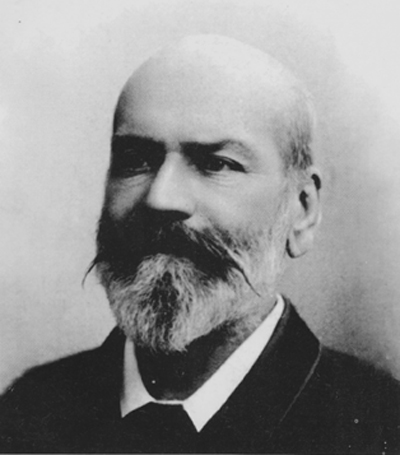|
One name that stands out in the early decades of the systematic herpetology of South India is Richard Henry Beddome (11.5.1830-23.2.1911).
Henry Beddome was the eldest son of Richard Boswell Brandon Beddome, a London solicitor. He was educated at Charterhouse School in Surrey, a leading Public School.
Schooling finished, he studied for the legal profession, but could not get interested in it and preferred a life abroad. He joined the Army, obtaining a direct cadetship in 1848 in the East India Company’s service and was sent to India. He was posted to the 42nd Madras Native Infantry. He was with that Regiment at Jabalpur in 1856, serving as Quartermaster and Interpreter of the regiment, and from there he went to Secunderabad.
 Richard Henry Beddome. |
Soon after his arrival in Madras, at the end of 1856, he was appointed to the Madras Forest Department, and never rejoined his regiment. In 1857, due to his profound fascination for natural history, he was selected as an assistant to Dr. Hugh Cleghorn and became the Chief Conservator of Forests, in which position he continued until 1882. Meanwhile, in 1880, due to his scholarly contributions to the natural history of Southern India, he became a Member of the University of Madras.
Aside from botany, he is best known for his herpetological studies in Southern India. His most outstanding contribution is the series of collections and descriptions that he made in the Eastern and Western Ghats, which forms part of a global biodiversity hotspot rich in endemism.
His herpetological collections, most of which he described, were deposited in the Natural History Museum in London and the Indian Museum, Calcutta (now with the Zoological Survey of India, Kolkata). He retired from service in 1892 and died in 1911.
His name has been immortalised by his numerous contributions to South India’s herpetology. These are of interest to the student of Indian herpetology even today, a century later.
During the 24 years between 1862 and 1886 Beddome published 15 papers on the subject, most of which contained description of at least one new species. These included several notes on the land and freshwater snakes of the Madras Presidency, with a particular focus on the family Uropeltidae as well as notes on several species lizards.
|
Many of his peers named new South Indian herpetological
taxa honouring him. These include:
Ichthyophis beddomei Peters, 1879*
Bufo beddomei Gunther, 1876*
Philautus beddomei (Gunther, 1875)*
Rhacophorus beddomei Boulenger, 1882 (preoccupied); now known as Rhacophorus calcadensis Ahl, 1927 (replacement name)
Indirana beddomii (Gunther, 1875)*
Nyctibatrachus beddomii (Boulenger, 1882)*
Cnemaspis beddomii (Theobald, 1876)*
Otocryptis beddomii Boulenger, 1885*
Eutropis beddomei (Jerdon, 1870)*
Kaestlea beddomii (Boulenger, 1887)*
Ristella beddomii Boulenger, 1887*
Ophisops beddomii (Jerdon, 1870)*
Typhlops beddomii Boulenger, 1890*
Typhlops beddomii (not of Boulenger, 1890) Wall, 1919 (preoccupied); now Typhlops tindalli Smith, 1943)
Uropeltis beddomii (Gunther, 1862)*
Amphiesma beddomii (Gunther, 1864)*
Boiga beddomii (Wall, 1909)*
Calliophis beddomii Smith, 1943*
(*indicates species currently valid as Beddome’s eponym) |
Several dozens of new herpetological taxa that are still valid today were collected and described by Beddome. Although his contribution to systematic research on amphibians (frogs, toads, etc.) is minor, his reptile descriptions are numerous. Chief among them are the uropeltid snakes and several geckoes and skinks from both the Eastern and Western Ghats mountain ranges. His contributions to our knowledge of the uropeltids are still important even a century after his death, for very little has been added to what we know of this elusive group of snakes endemic to southwest India and Sri Lanka, barring the work of M.V. Rajendran (1916-1993).
For his extensive contributions to Indian herpetology, including descriptions of 70 herpetological species, Beddome has been lauded by many of his contemporaries, peers and even some of the more recent workers in the field.
Here are a few examples of such tributes, one each from the 19th, 20th and 21st Centuries so as to highlight this fact.
“Lieut. Col. Beddome’s collection contains all the specimens obtained by him during his residence in India, more especially the types of the numerous interesting forms discovered and described by him. Perhaps there is now no other part of India, the reptilian fauna of which is better known than the district explored by this indefatigable collector.”
– Gunther (1875)
“…(Colonel Beddome)… exploited the South Indian Hills, including the Palni Hills, to such purpose in the seventies and eighties of the last century, that he has hardly left a snake for any later enthusiast to discover.”
– Wall (1921)
“He described the new genus Melanobatrachus and four other species. From the remarkable collections he made, Albert Gunther and George Albert Boulenger could describe about 20 new species. The fact that six Western Ghats amphibians were named after him shows how amphibian specialists have accepted him as a recognised herpetologist.”
– Biju (2001)
The list (box above) shows that many of his peers regarded Beddome as one of the foremost authorities on South India’s herpetology. From as early as 1862 to as late as 1943, for over eight decades, several leading herpetologists have named new South Indian herpetological taxa after him, which speak of the high regard in which they held him. Beddome’s legacy will not be forgotten. It is to be hoped that it will inspire present and future herpetologists to explore the diversity hidden within the last remaining forest patches of peninsular India. (Courtesy: Cobra, the journal of the Chennai Snake Park Trust.)
|